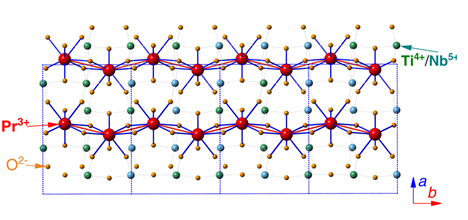Studying the crystalline material PrTiNbO6, a group of researchers has observed a quantum magnetic phase that has previously only been described by simulations. By using neutrons and muons at ISIS, they have confirmed that the compound forms a quantum Griffiths phase.
This phase occurs when there is randomness in both the transverse fields and couplings, and is described by the random transverse-field Ising spin chain (RTIC) model. Although well described in model systems, the phase had previously not been observed experimentally.
In PrTiNbO6, the splitting of the crystal electric field (CEF) levels of the Pr3+ ions present in the crystal creates effective Ising moments, which were measured directly using MERLIN. The splittings are effected by the random distribution of the Ti4+ and Nb5+ ions, giving rise to random transverse fields and Ising couplings.

The crystal structure of PrTiNbO6 viewed in the ab plane, where the dashed blue lines indicate the unit cells. npj Quantum Mater. 6, 34 (2021)
In their study, published in npj Quantum Materials, the researchers used Inelastic Neutron Scattering (INS) on LET to measure the equilibrium thermodynamic properties of a single crystal of PrTiNbO6, finding that they matched the RTIC model well.
They extended their study, using muon spin resonance on MuSR, and further INS measurements on LET, to investigate the internal local magnetic fields and the dynamic spin correlations and excitations. Again, they found that the model that included the randomness was better able to describe the behaviour of the system.
Using their RTIC model, fitted to the experimental data, the group was able to analyse the origin of the quantum Griffiths singularity. They found the existence of two low-lying energy states that are almost degenerate, and which behave as a “quibit". In the quantum Griffiths rare region (QGRR), these states contribute a non-zero net magnetic moment to the random quantum Ising chain.
As the quantum Griffiths phase is caused by the random distribution of ions on specific sites in the crystal structure, this study suggests the phase may also be found in other Pr- and Tm- based compounds that have site-mixing.

a Wave-vector dependence of the spin excitation continuum measured at 0.4 ≤ E ≤ 0.8 meV at 0.1 K. b Energy dependence of the continuum along the b axis. c Energy dependence of the measured intensities at the M (solid scatters) and Γ (open scatters) points, respectively. d Illustration of the energy spectrum where the two-lowest levels represent a QGRR. npj Quantum Mater. 6, 34 (2021)
Further information
The full paper can be found at DOI: 10.1038/s41535-021-00333-6
